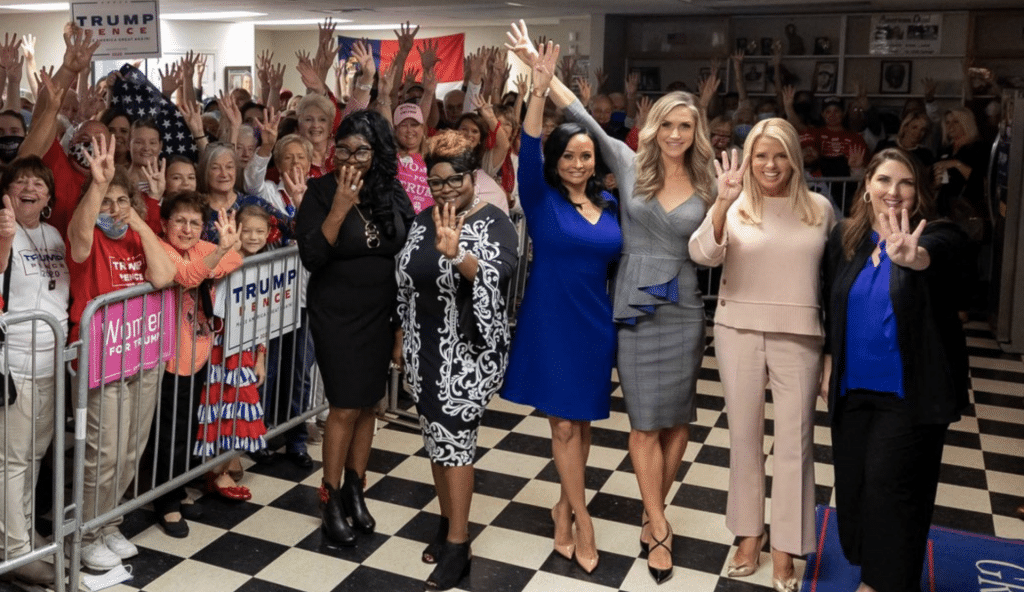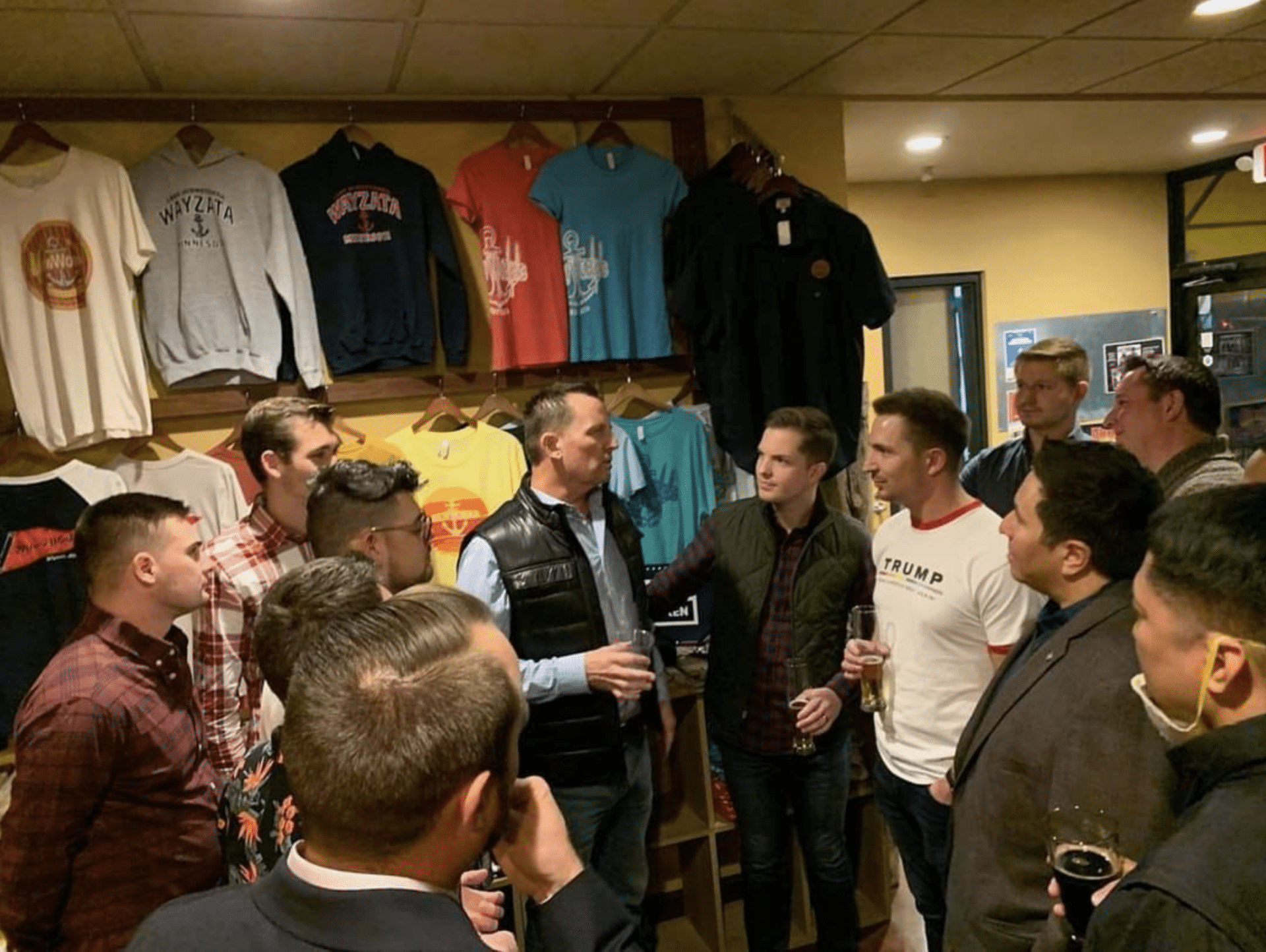How Lara Trump and other presidential surrogates flout pandemic best practices—indoors
By Matt Field | October 30, 2020
 Dozens of Trump supporters crowd around the president's daughter-in-law, Lara Trump, and other campaign surrogates. Credit: the Trump Women's Tour twitter feed.
Dozens of Trump supporters crowd around the president's daughter-in-law, Lara Trump, and other campaign surrogates. Credit: the Trump Women's Tour twitter feed.
In one shot—the cool shot—a sea of cheering people goes wild as a Marine Corps helicopter flies low beyond the edge of the crowd, its rotors kicking up dust as CCR’s “Fortunate Son” plays in the background. In the other shot—the uncool one—a handful of people stand in circular social-distancing circles on the ground as Joe Biden walks by them and toward an outdoor stage. President Donald Trump obviously thought the contrast between his rally and Biden’s event spoke for itself; his tweet containing the videos had no words. His message, though, was crystal clear: Social distancing—one of the best tools we have to stop the spread of the surging coronavirus—is lame.
Trump hasn’t let the pandemic stop him from hosting the sort of huge rallies that helped him get elected president in the first place, not even after he caught COVID-19 and his doctors put him on a potentially life-saving experimental drug cocktail. Local officials and public health experts have criticized his re-election campaign rallies, which, though mainly outdoors where the coronavirus spreads less readily, still involve thousands of people standing cheek by jowl for hours on end, frequently without wearing face masks.
As risky as Trump’s rallies might be from an epidemiological standpoint, if you look one or two levels down on the Trump campaign surrogate chart, the picture is even worse.
Take the Trump Women’s Tour. Campaign surrogates like presidential daughter-in-law Lara Trump, Republican National Committee Chair Ronna McDaniel, and aide Katrina Pierson, among others, have held a host of events in swing states, often indoors.
One photo on the tour’s Twitter feed, depicts dozens of supporters in Burlington, North Carolina, squeezing up against fencing to catch a glimpse of Pierson, Lara Trump, McDaniel, former Florida attorney general Pam Bondi, and the podcasters known as Diamond and Silk. The surrogates, along with many of the supporters, are not wearing masks. Several in the crowd appear older, and one woman has plastic tubing in her nose.
Coronavirus cases in North Carolina are shooting up, just as they are in much of the country. On Oct. 28, the day the women’s tour event in Burlington was held, the state recorded 39 COVID-19 deaths and 2,232 new cases. A day later, Gaston County health officials announced that two people who had attended a large rally the president held on Oct. 21 tested positive for COVID-19. Gov. Roy Cooper, a Democrat, said recently that he is “really concerned about campaigns that fly in all over the place and come into North Carolina, hold these large events, gathering a lot of people together, also bringing in people from out of state, and then leaving.”
While Cooper has issued orders to restrict the size of gatherings—putting a 25-person limit on indoor groups, for instance—Catie Armstrong, a spokeswoman for the North Carolina Department of Health and Human Services said, “activities constituting the exercise of First Amendment rights are exempt from the requirements of the Governor’s Executive Orders.” Nonetheless, she said, “large gatherings increase the risk of spreading COVID-19.”
The women’s tour event in Burlington didn’t break any laws. “This is not a legal issue,” Tim Wigginton, the press secretary for the Republican party in North Carolina said. But experts say the indoors is where the virus spreads most easily. Some advocate for a layered approach to protection, one that includes, wearing masks, social distancing, socializing outside, etc. Under that model, the organizers of the Oct. 28 event disregarded nearly every protective layer.
“It’s important we are able to connect with voters,” Wigginton said. The spokesman said most Republican events are outdoors, and that the women’s tour event was moved indoors because of rain.
“We encourage everyone to wear masks and take COVID seriously, but everyone knows their own situation and should take personal responsibility for their own decisions,” he said.

The Trump Women’s Tour account has posted pictures of other indoor events in Michigan, Wisconsin, and Ohio; neither attendees nor surrogates routinely appear to be wearing masks. The Trump campaign did not respond to request for comment on this story.
The women’s tour isn’t the only example of Trump surrogates hosting or attending indoor events in virus hotspots. Richard Grenell, the former acting Director of National Intelligence and former US ambassador to Germany, has attended several in recent weeks.
Grenell mingled on Oct. 21 with a crowd at a brewery west of Minneapolis at a Republican Party event there. In one picture on the Log Cabin Republicans of Minnesota Facebook page, Grenell can be seen talking with at least 10 men in a circle; no masks were worn and everyone was bunched up near a rack of for-sale t-shirts. After another indoor event, the Michigan GOP thanked Grenell in a tweet on Oct. 21 for touring the swing state. The accompanying video shows Grenell in a crowd of people jammed together inside chanting “four more years.” In Florida, the president’s eldest son, Donald Trump Jr., held a rally in Panama City Beach earlier in October, packing dozens of supporters into a Holiday Inn hotel, according to Business Insider.
The events depict a campaign that sees little need to adhere to best practices when it comes to preventing the spread of COVID-19, even after the president and several others who attended a White House event last month for Trump’s Supreme Court pick, Amy Coney Barrett, tested positive for the virus. Anthony Fauci, the director of the National Institute of Allergy and Infectious Diseases, called the gathering a “superspreader event” that further highlighted the need to wear masks and not crowd together.
With no vaccine to stop the coronavirus and cases soaring once again in the United States and around the world, wearing masks and social distancing are among the main defenses that public health experts recommend to fight against COVID-19. But Trump often criticizes these measures on style grounds. Mocking his Democratic opponent at the first of two presidential election debates, Trump said Biden “could be speaking 200 feet away, and he shows up with the biggest mask I’ve ever seen.”
Later in North Carolina, Trump told a crowd his thoughts on the socially distanced car rallies Biden was holding: “They showed it, it was a tiny, tiny little crowd. You heard a couple of horns–honk, honk.”
Trump has implied that the severity of the pandemic is partly a matter of how people perceive it. “Don’t let it dominate your life,” the president tweeted after leaving Walter Reed Medical Center in early October. His condition had been “very concerning” according to his chief of staff, and at the prestigious medical center, Trump received an experimental monoclonal antibody therapy not available to the general public.
But as the rising numbers of infections and death show, the virus that causes COVID-19 and the pandemic can’t be willed away. They are deadly real and impervious to big crowds and military helicopters.
Together, we make the world safer.
The Bulletin elevates expert voices above the noise. But as an independent nonprofit organization, our operations depend on the support of readers like you. Help us continue to deliver quality journalism that holds leaders accountable. Your support of our work at any level is important. In return, we promise our coverage will be understandable, influential, vigilant, solution-oriented, and fair-minded. Together we can make a difference.
Keywords: 2020 election, Coronavirus, Donald Trump, Joe Biden, masks, social distancing
Topics: Analysis, Disruptive Technologies
















Jim Jones phoned from Hell. He wants Donald Trump to know he’s a big fan.